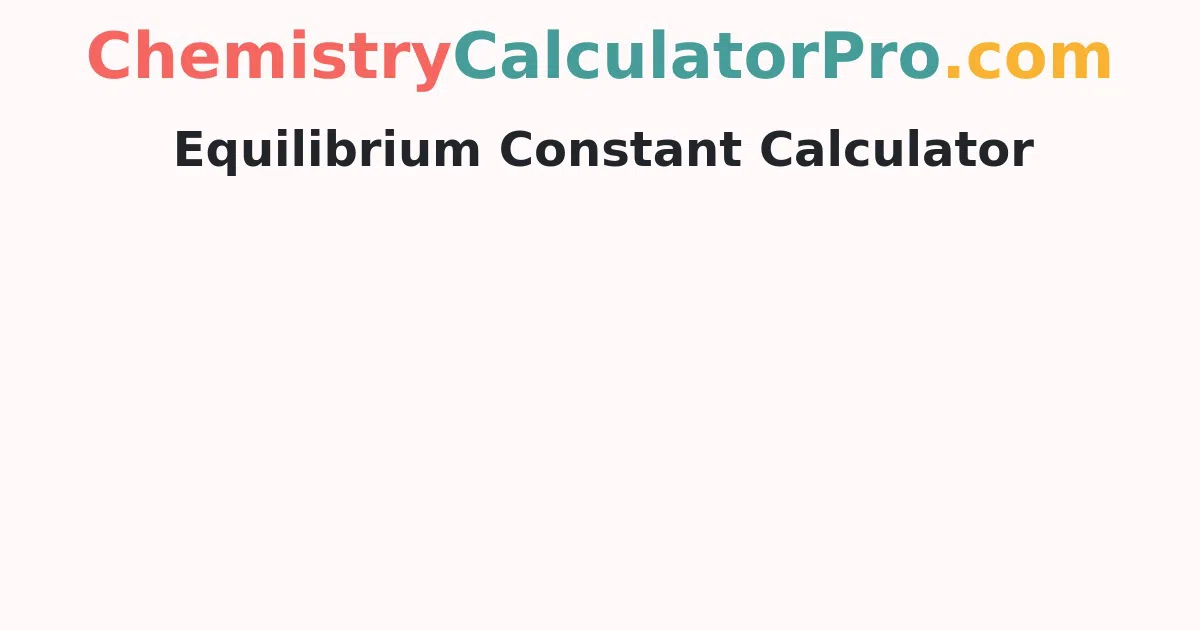Equilibrium Constant Calculator
Equilibrium Constant Calculator is a free tool that allows you to quickly calculate the equilibrium constant of a reversible chemical reaction. It simply takes the coefficient, as well as the concentrations of both reactants and products, as input and outputs the equilibrium constant in a matter of seconds.
What is Equilibrium Constant?
In a reversible reaction, both forward and reverse reactions happen at the same time. After a particular amount of time, an equilibrium is reached in which the rate of reactants becoming products equals the rate of products becoming reactants. The reaction is thought to be constant at this point in time. a[A] + b[B] ⇌ c[C] + d[D] is an example of a reversible reaction.
The equilibrium constant is independent of the reactant and product concentrations at the start. Temperature, solvent, and ionic strength all play a significant role.
Equilibrium Constant Equation
The equilibrium constant of a chemical process connects all of the reaction's species. The equation for the equilibrium constant is as follows K = ([C]c * [D]d)/([B]b * [A]a)
- Where, [A], [B] = molar concentrations of the reactants
- [C], [D] = molar concentrations of the products
- K = equilibrium constant
- Kc = conentration
Both the reactants' and products' partial pressures affect Kp. If K > 1, the equilibrium is in favour of the products and if K < 1, the equilibrium is in favour of the reactants. If K = 1, the combination is in equilibrium and contains similar amounts of both reactants and products.
How to Calculate Equilibrium Constant?
The steps to calculate the equilibrium constant of a chemical reaction is explained below. If you follow them, you'll get instant results.
- Step 1: Get the initial concentrations of the reactants and products, as well as their coefficients.
- Step 2: For all the products and reactants, calculate the molar concentration to the power of the coefficient.
- Step 3: Multiply the product and reactant values in the same way.
- Step 4: To find the equilibrium constant value, divide the product multiplication by the reactants.
How Do I Use the Equilibrium Constant Calculator?
The following is the procedure how to use the equilibrium constant calculator
- Step 1: Fill in the input field with the reactants, product coefficients, and concentrations.
- Step 2: To acquire the result, click the "Calculate Equilibrium Constant" button.
- Step 3: Finally, in the output field, the equilibrium constant for the selected chemical process will be presented.
FAQ’s on Equilibrium Constant Calculator
1. How do you use a calculator to compute the equilibrium constant?
In the supplied input fields, enter the concentration and coefficient of each product and reactant in the chemical reaction. Press the compute button to acquire the equilibrium constant and a step-by-step explanation in the output area.
2. What is a calculator for the equilibrium constant?
When forward and backward reactions occur at the same time, the equilibrium constant calculator can help you comprehend the reversible reactions. After the reaction achieves equilibrium, this tool calculates the equilibrium constant.
3. What is the value of K, the equilibrium constant?
The equilibrium constant (K) - A mathematical ratio that displays the product concentrations divided by the reactant concentrations.
4. What is the purpose of the equilibrium constant?
The equilibrium constant is used to study metabolic processes such as haemoglobin-mediated oxygen transport and acid-base homeostasis in humans. Because it is an indication of iron insufficiency, doctors will assess the equilibrium constant of transferrin in the blood.
